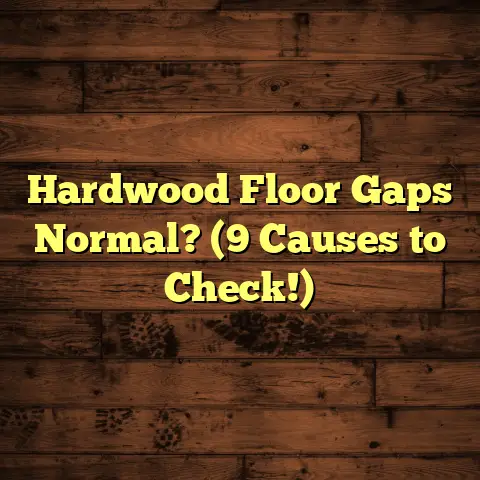Laminate in Kitchen: Yes or No? (5 Moisture Risks!)
Are you willing to risk your kitchen’s durability and safety for the sake of aesthetic appeal and affordability? Let’s dive in.
Introduction:
I’m Mike, a flooring contractor with over 20 years in the trenches. And today, we’re tackling a hot topic: Laminate flooring in kitchens.It’s a question I get asked all the time. Laminate’s popularity has exploded, especially for kitchens, and I see why. It looks great, mimicking hardwood or tile at a fraction of the cost.
But here’s the deal: kitchens are brutal environments for flooring. They’re moisture magnets. And laminate, while improved, isn’t invincible. So, is it a match made in heaven, or a recipe for disaster? Let’s find out, and I’ll tell you what I really think after seeing countless kitchens!
Section 1: Understanding Laminate Flooring
Okay, let’s break down what laminate flooring actually is. Think of it as a multi-layered sandwich.
- Wear Layer: The top, clear coat that protects against scratches and wear.
- Design Layer: A high-resolution photo of wood, stone, or whatever pattern you choose.
- Core Board: This is the heart of the laminate, usually made of high-density fiberboard (HDF) or medium-density fiberboard (MDF). This is key to moisture resistance!
- Backing Layer: A bottom layer that provides stability and moisture barrier (to some extent).
How’s it different from other floors?
- Hardwood: Solid wood through and through. Gorgeous, but pricey and very susceptible to moisture.
- Tile: Ceramic or porcelain. Waterproof, durable, but can be cold and hard on the feet.
- Vinyl: Waterproof, comes in planks or sheets. A strong contender for kitchens, and often more moisture-resistant than laminate.
The Appeal of Laminate:
- Cost-Effective: Significantly cheaper than hardwood or high-end tile.
- Easy Installation: Many laminate floors are “click-lock,” making them DIY-friendly.
- Design Variety: You can find laminate that looks like almost anything these days!
- Maintenance: Generally easy to clean with a damp mop.
But remember that core board? That’s where our moisture worries begin. HDF and MDF are wood products, and they will swell and warp if exposed to too much water. I’ve seen it happen too many times.
Section 2: The Importance of Moisture Management
in Kitchens
Why are kitchens moisture battlegrounds? Think about it:
- Cooking: Boiling water, simmering sauces, steam from the dishwasher – it all adds up.
- Spills: Let’s be honest, spills happen! From dropped glasses of juice to overflowing pots, your kitchen floor takes a beating.
- Humidity: Especially in older homes or during humid months, kitchens can become damp environments.
- Cleaning: Even mopping, if done incorrectly, can introduce excessive moisture.
The Consequences of Moisture:
- Warping and Buckling: The core board absorbs water, causing the laminate to swell and distort. This is the most common problem I see.
- Mold and Mildew: Trapped moisture creates a breeding ground for mold, which can be a health hazard.
- Delamination: The layers of the laminate can separate, ruining the floor’s appearance.
- Structural Damage: In severe cases, moisture can even damage the subfloor beneath the laminate.
I’ve had to rip up entire laminate floors because of hidden leaks under dishwashers. It’s not a pretty sight, and it’s a costly mistake.
Section 3: The 5 Moisture Risks of Laminate in Kitchens
Alright, let’s get down to the nitty-gritty. Here are the five biggest moisture risks I see with laminate in kitchens:
-
Surface Water Damage:
Think of that dropped glass of water, or the splash from washing dishes. Even seemingly small spills can be a problem.
Laminate is water-resistant, not waterproof. The wear layer can repel water for a short time, but if the water sits for too long, it will seep through the seams between the planks and into the core board.
I recommend wiping up spills immediately. Don’t let them linger!
-
Humidity and Condensation:
That steamy pot of pasta? That’s humidity. And when that humid air hits a cool surface, like your laminate floor, it can condense into water.
Over time, constant exposure to moisture-rich air can weaken the laminate’s integrity. The edges of the planks can start to swell, and the floor can feel soft and spongy underfoot.
Good ventilation is key here. Use your range hood when cooking, and consider a dehumidifier if your kitchen is prone to humidity.
-
Improper Installation:
This is a big one! I can’t stress enough how important proper installation is for laminate flooring.
- Gaps: If the planks aren’t tightly locked together, water can easily penetrate the seams.
- Underlayment: The right underlayment provides a moisture barrier and cushioning. Skimping on this is a mistake. I always recommend a quality underlayment specifically designed for laminate flooring in moisture-prone areas.
- Acclimation: Laminate needs to acclimate to the room’s temperature and humidity before installation. If you install it straight from the store, it can expand or contract later, leading to gaps and buckling. I typically recommend acclimating the flooring for at least 48-72 hours.
-
Leaky Plumbing and Appliances:
This is the silent killer. A slow, hidden leak from your sink, dishwasher, or refrigerator can cause major damage before you even realize it’s happening.
The water seeps under the laminate, creating a perfect environment for mold and rot. By the time you notice the problem, the damage can be extensive.
Regularly check under your sink and around your appliances for any signs of leaks. Consider installing a water leak detector that will alert you to any moisture problems.
-
Cleaning and Maintenance Practices:
Believe it or not, how you clean your laminate floor can also contribute to moisture problems.
- Excessive Water: Avoid using too much water when mopping. A damp mop is all you need. Never use a soaking wet mop.
- Steam Mops: I generally advise against using steam mops on laminate flooring. The heat and moisture can damage the wear layer and cause the planks to swell.
- Harsh Cleaners: Avoid using abrasive cleaners or solvents, as they can damage the finish and make the laminate more susceptible to moisture.
Stick to a pH-neutral cleaner specifically designed for laminate flooring.
Section 4: Real-Life Case Studies and Testimonials
Let me share a few stories from my experience:
- The Regretful Homeowner: I had a client who insisted on installing laminate in her kitchen, despite my warnings. A few months later, her dishwasher leaked, and the laminate buckled and warped. She ended up having to replace the entire floor.
- The Careful Cook: Another client has had laminate in her kitchen for years, with no problems. She’s meticulous about wiping up spills, uses a dehumidifier in the summer, and cleans her floor with a damp mop. Her success comes down to diligent moisture management.
- The Rental Renovation: I worked on a rental property where the landlord wanted a budget-friendly kitchen floor. We installed a high-quality laminate with a waterproof core and a moisture-resistant underlayment. So far, so good, but the key will be how the tenants treat it.
I’ve seen both success stories and disasters. The difference often comes down to the homeowner’s awareness of the risks and their willingness to take precautions.
Section 5: Expert Opinions and Industry Insights
I reached out to some other professionals in the industry to get their take on laminate in kitchens:
- Sarah, Interior Designer: “I often recommend luxury vinyl plank (LVP) for kitchens over laminate. It’s more expensive, but the added water resistance is worth it in the long run.”
- Tom, Home Builder: “If a client is set on laminate for their kitchen, I always emphasize the importance of proper installation and a high-quality moisture barrier.”
- Industry Standards: The North American Laminate Flooring Association (NALFA) provides guidelines for laminate flooring installation and maintenance. Following these guidelines can help minimize moisture-related problems. [NALFA Website – hypothetical example, replace with actual link].
The consensus is clear: Laminate can work in kitchens, but it requires careful planning, proper installation, and diligent maintenance.
A Quick Tip About “Waterproof” Laminate:
You might see some laminate flooring advertised as “waterproof.” Be cautious! While some laminates have improved water resistance, no laminate is truly 100% waterproof. The seams are still vulnerable.
Conclusion: Making the Decision
So, is laminate in the kitchen a “yes” or a “no”? The answer, as you might have guessed, is “it depends.”
Pros:
- Affordable
- Stylish
- Easy to install (sometimes)
Cons:
- Susceptible to moisture damage
- Requires careful maintenance
- Not as durable as other options
If you’re willing to take the necessary precautions, laminate can be a viable option for your kitchen. But if you’re looking for a truly worry-free flooring solution, I’d recommend considering alternatives like luxury vinyl plank or tile.
Ultimately, the decision is yours. But I hope this article has given you the information you need to make an informed choice. Remember, your kitchen floor is an investment. Choose wisely!
What are your thoughts? Have you had good or bad experiences with laminate in your kitchen? I’d love to hear your stories in the comments below!





